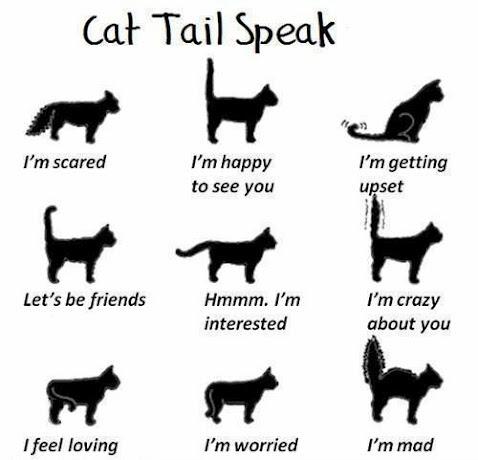Have you ever noticed your cat strutting around with their tail held high, resembling a proud little flag? While feline behavior can sometimes leave us scratching our heads, understanding these subtle signals is essential for any cat owner wanting to deepen their bond with their furry friend. A tail held straight up is more than just a posture; it’s a fascinating aspect of cat communication that reveals their feelings and intentions.
In this article, we’ll explore what this charming gesture signifies in the world of feline body language, helping you decipher your cat’s moods and emotions with confidence. From asserting confidence to expressing curiosity, a cat’s tail can tell you a lot about their state of mind. Let’s embark on this journey into the delightful realm of our whiskered companions!
Table of Contents
- Understanding the Significance of a Cats Tail Position
- Common Emotions Associated with a Tail Held High
- Interpreting Other Tail Movements and Their Meanings
- Tips for Enhancing Communication with Your Feline Friend
- Q&A
- Concluding Remarks
Understanding the Significance of a Cats Tail Position
When it comes to understanding feline communication, a cat’s tail position is one of the most telling indicators of their mood and intentions. A tail held straight up, often with a slight curve at the end, is typically a sign of a happy and confident cat. This posture is akin to a friendly wave, indicating that your feline friend is feeling secure and is open to interaction. Much like humans smile to convey positivity, cats use their tails to express similar sentiments. Observing this tail position can help cat owners better engage with their pets, enhancing the bond between them.
In addition to general happiness, a straight-up tail can also signify that your cat is feeling curious or excited about their environment. It’s not just about the tail, but also the accompanying body language which can provide further context. For instance, when combined with a relaxed body and slow blinks, this tail position suggests trust and affection. Conversely, if the tail is erect but the cat appears tense, it may indicate that they are on high alert or curious about something. Understanding these nuances allows owners to foster a deeper connection with their furry companions.

Common Emotions Associated with a Tail Held High
When a cat holds its tail high, it’s a universal sign of confidence and contentment. This posture radiates positive energy and indicates that the cat feels safe in its environment. It often means your feline friend is in a good mood and is ready to engage with the world around them. A tail held high can signal various emotions, including:
- Happiness: They are feeling joyful and interactive.
- Curiosity: A high tail often accompanies their exploration of new surroundings.
- Affection: Cats may greet their owners with a raised tail as a friendly gesture.
It’s important to note that this tail position can also vary depending on the context. For instance, a cat with a high tail may flick it gently when intrigued or excited, or it might hold it stiffly when marking territory. Understanding these subtle differences can help you decode your cat’s emotions more accurately. Here’s a quick reference table to help you identify the nuances:
| Tail Position | Emotion |
|---|---|
| High and Straight | Confidence, Happiness |
| High with a Flick | Excitement, Curiosity |
| High but Stiff | Territorial, Assertive |
Interpreting Other Tail Movements and Their Meanings
Understanding your cat’s body language extends beyond just the tail held high. Different tail movements can convey a variety of emotions and intentions. Here are some common tail positions and what they typically signify:
- Tail Flicking: A flicking tail may indicate excitement or agitation. Keep an eye on the rest of their body language for context.
- Curled Tail: A tail curled around the body often signifies contentment and relaxation, indicating that your cat feels safe.
- Fluffed Tail: An agitated or fearful cat may puff up their tail to appear larger and more intimidating to potential threats.
- Low-Angled Tail: A tail held low can indicate submission or insecurity, especially in multi-pet households.
Additionally, there are some nuanced movements that can provide deeper insights into your feline friend’s mood:
| Tail Movement | Meaning |
|---|---|
| Slowly waving tail | Curiosity and interest |
| Side-to-side swishing | Potential aggression or irritation |
| Tail wrapped around another cat | Affection and bonding |
By paying attention to these tail movements and their meanings, you can better understand your cat’s emotional state and respond appropriately to their needs and feelings.
Tips for Enhancing Communication with Your Feline Friend
Understanding your cat’s body language is essential for establishing a stronger bond with your feline companion. One of the most telling signs is the position of their tail. A tail held straight up often signifies that your cat is feeling happy, confident, and ready to engage. To enhance communication, consider these practical tips:
- Observe Regularly: Spend time watching your cat’s tail and body positions. This will help you learn their unique signals over time.
- Respond Appropriately: If your cat approaches you with their tail raised, respond with gentle affection or play. This positive reinforcement encourages more interactions.
- Create a Comfortable Environment: Ensure your cat has safe spaces to retreat to, making them more likely to exhibit relaxed behavior.
Another important aspect of feline communication is vocalization. Cats use various sounds to express emotions, from soft purring to loud meowing. Pay attention to the context in which these sounds occur to gain insight into what your cat may be expressing. Below is a simple table outlining common vocalizations and their meanings:
| Vocalization | Meaning |
|---|---|
| Purring | Contentment or relaxation |
| Meowing | Seeking attention or food |
| Chirping | Excitement or playfulness |
| Hissing | Discomfort or fear |
Q&A
Q&A: Cat Tail Straight Up Meaning – Decoding Feline Body Language
Q1: What does it mean when a cat’s tail is straight up?
A1: A cat with its tail held straight up is typically expressing confidence, happiness, or friendliness. It’s a positive sign that your feline friend is feeling secure in their environment and may be ready to interact with you or other pets.
Q2: Are there different meanings for a tail held at various heights?
A2: Yes! The height of a cat’s tail can convey different emotions. A tail that is straight up suggests confidence, while a tail held lower might indicate uncertainty or relaxation. Conversely, a puffed-up tail usually indicates agitation or fear, as the cat is trying to appear larger.
Q3: Do cats always hold their tails straight up when they’re happy?
A3: While a straight-up tail is often a sign of happiness, it can also vary depending on the cat’s individual temperament and the context. For example, some cats may raise their tails when they’re curious or exploring. Always consider the overall body language and environment to get a fuller picture of your cat’s feelings.
Q4: Can a cat’s tail position change based on social interactions?
A4: Absolutely! When interacting with humans or other cats, a tail held straight up can indicate an invitation for social interaction. If your cat approaches you with their tail raised, it’s a friendly gesture, signaling they want to engage or seek affection.
Q5: What if my cat’s tail is straight up but it seems agitated?
A5: If your cat’s tail is up but other signs of agitation appear—such as flattened ears, dilated pupils, or hissing—it may indicate a mix of feelings, such as excitement paired with anxiety. In such cases, it’s best to give your cat space until they settle down.
Q6: How can I use this information to improve my relationship with my cat?
A6: Understanding your cat’s body language can help you respond more appropriately to their needs. When your cat approaches you with a straight-up tail, consider this a cue to engage with them. Play or pet them gently to reinforce their positive feelings, strengthening your bond.
Q7: Are there any other tail positions I should be aware of?
A7: Definitely! A tail held low may suggest submission or relaxation, while a tail curled around another cat signifies affection. A side-slanted tail can indicate playfulness, and a rapidly flicking tail often signals irritation. Observing these different positions can help you better understand your cat’s mood and intentions.
Q8: How does understanding tail language benefit cat owners?
A8: Recognizing tail language can enhance communication with your cat, leading to a deeper understanding of their emotional state. This awareness fosters a more harmonious relationship, allowing you to cater to their needs and provide a loving environment.
Q9: Where can I learn more about cat body language?
A9: There are many resources available, including books on feline behavior, websites dedicated to pet care, and even videos that showcase cat body language. Local animal shelters or veterinarians can also provide valuable insights and tips on understanding your furry friend.
Concluding Remarks
understanding your cat’s body language can enhance the bond you share with your feline friend. A tail held high is not just a whimsical gesture; it is a clear signal of confidence, happiness, and a friendly disposition. By paying attention to these subtle cues, you’ll not only decode their emotions but also create a more harmonious environment for both of you. So next time you see your cat strutting around with their tail straight up, remember that they are feeling content and secure—an invitation for affection and interaction. Embrace these moments, and let the unique language of your cat enrich your everyday life! Happy observing!
















